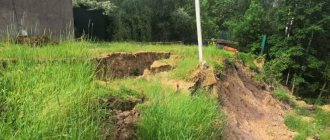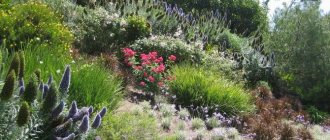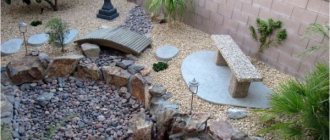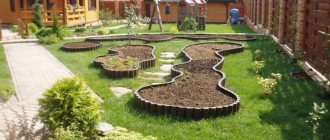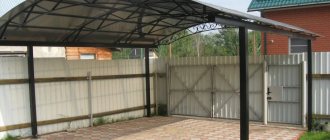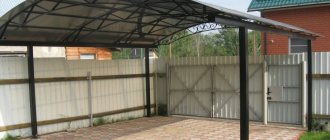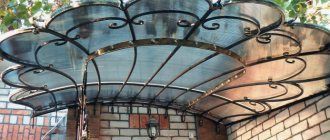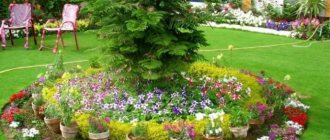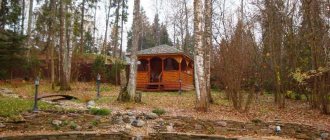With the right approach, a ravine on a site can be turned into a decorative and functional area. There are no identical slopes. Therefore, it is necessary to proceed from the characteristics of each specific site, taking into account its size and the specifics of the relief. If the area is at least 30 acres, and the size of the ravine is small, it will be quite easy to beat it. For example, in this place you can organize a pond, and turn the shore into a comfortable beach. If it is not practical to make a pond, you can plant a garden on the slopes.
On a small plot, for example, an area of 6 acres, and almost completely occupied by a ravine, the situation is much more complicated. Here you need to build a house and other necessary buildings, arrange a vegetable garden, and you probably want to make a flower bed. In this case, it is necessary to strengthen the slopes, change the topography, select optimal plants (many varieties cannot grow normally in ravines), and provide protection from moisture, since in the spring such areas are usually heavily flooded.
It is necessary to take into account the angle of the slopes. The degree of their strengthening depends on this indicator. Based on specific features, the following measures can be taken:
- completely filling the ravine with soil to level the terrain;
- strengthening slopes, since any ravine has a moving surface, the soil moves and crumbles;
- beautification (planting plants, placing decorations), construction of a house and outbuildings. The relief practically does not change, but adapts to specific needs.
Safety measures on the slope
To avoid the risk of a landslide, every three to four terraces down the slope a permanent wall is built in the form of a gabion or rubble-cement masonry 60-80 cm wide. Such a wall can effectively strengthen a slope 10-15 m long. A stone wall must have binder, for example, cement, lime, clay mortar, or, as in the case of gabion, steel mesh.
Often, the masonry is strengthened by installing piles made of asbestos-cement pipes; this makes it possible to seriously strengthen the barrier and reduce the size of the masonry. Safety paths must be provided on broken terraces. In essence, these are ordinary paths or stairs leading down or up a slope, the base of which is reinforced with geogrid, gravel and anchor rods.
This solution allows you to create terraces of unlimited length without the risk of soil sliding. In addition, drainage trays are installed on the paths, discharging water down the slope of the summer cottage. Of course, paths and stairs can be made in the form of a snake or a broken march, this will only strengthen the slope.
A good addition would be to plant low-growing shrubs, such as gooseberries or currants, along the edge of the terrace; this will strengthen the edge and prevent the terrace from crumbling.
How to strengthen a ravine in a summer cottage with the help of plants
To choose the optimal method for strengthening a ravine, you must first find out its etiology and eliminate the causes of erosion. If the slope simply has a natural relief slope of up to 8%, you can do without organizing stepped terraces as a reinforcing structure.
Planting plants with a taproot type will help to fully strengthen not only the top layer of soil, but also the deeper layers. With proper plant care, such plantings will only strengthen over time as trees and shrubs grow. A significant disadvantage of how to strengthen a ravine in a summer cottage with the help of vegetation is that the achievement of the maximum effectiveness of the method is very delayed in time.
What plants can strengthen steep clones and pond banks?
- Willow is able to survive in places where there is an excess of water, so it is suitable for strengthening the banks of reservoirs and is suitable for natural soil drainage.
- Linden copes well with drainage, and this tree grows quite quickly. In order for the seedlings to take root and the root system to be able to strengthen with excess moisture, it is necessary to organize root holes near the seedlings.
- Creeping junipers strengthen slopes and declines well, but it must be taken into account that all conifers except pines grow extremely slowly. Therefore, it is better to purchase junipers, thujas, bush yew and other plants from the coniferous department as grown 5-year-old seedlings, but they take root successfully only with careful care in compliance with the rules of planting in a coma of earth.
- Not only trees, but also shrubs and grasses are suitable for strengthening depressions. Raspberry bushes, blackberries, and various types of barberries have a strongly growing root system.
- Lawn grasses (bluegrass, timothy, fescue) provide good turf cover on gentle slopes. If very acidified areas of soil are located in illuminated areas, then heathers, loosestrife, white and red clover, and lupine are suitable for strengthening the slopes.
How to stop soil sliding in a summer cottage using technological methods
If the biological method of strengthening slopes is not effective enough at the initial stage or the speed of achieving the effect is not satisfactory, you can strengthen the slopes with biomats made of cellulose fibers or coconut. Mats can be a temporary measure, since the service life of mats is 2-3 years without changing or weakening the structure. Therefore, mats are purchased in order to first allow plantings to develop. Geotextiles, geogrids and geomats will help you decide how to effectively strengthen the ravine in your summer cottage and will not interfere with the future growth of plants. Geotextile fabric is made of polypropylene and has a lattice structure. The material is suitable for slopes with an inclination angle of up to 60*
It is important to maintain the distance recommended by the manufacturer between the mounting anchors. Plants can be planted on top of geomaterials due to their porous structure, through which air and moisture can easily penetrate. Strengthening slopes with gabions is one of the most reliable, but expensive methods
Gabions are special nets filled with stones, crushed stone, soil or wood. Reinforcing structures made from gabions can be erected fairly quickly and, if installed correctly, will serve reliably for many years. Even objects of small architectural forms can be erected from gabions.
In order to save on the purchase of materials, you can use combined methods to stop the soil from sliding in your summer cottage. Geomaterials can be used after redevelopment of problem areas on a summer cottage to strengthen edge lines. If your dacha has a lot of construction waste from broken bricks, gypsum blocks or ceramics, then you can make gabions yourself, which will be several times cheaper than ready-made blocks.
How much does Geogrid cost?
148.94 RUR/m2. RUB 274.99/sq. m.
Interesting materials:
What happens if you drive with a handbrake? What happens if you save energy? What happens if you drive on worn brake discs? What happens if an oxygen cylinder is lubricated with oil? What happens if a tire bursts at speed? What happens if the front wheel bursts? What happens if you drive an automatic with handbrake? What happens if you pour a lot of powder into the washing machine? What happens if there is no zero? What happens if you don't save electricity?
Strengthening slopes and slopes at the dacha
If we talk about the standard six hundred square meters within the boundaries of the cooperative, then practically no such problems arise, but if the dacha is located outside the city, then it is often built near a forest or river. But here the terrain can change very much. That is why DachaDecor.ru today talks about the topic of slopes and slopes that need to be strengthened.
If you are unlucky, you have acquired a dacha area with uneven terrain. Consider the positive aspects of these unpleasant surprises.
First, notice the advantages of the unusualness of the land:
- Completely eliminates the occurrence of stagnation of rain and groundwater in areas with some slopes.
- The planes facing the sun are well illuminated, as a result of which ornamental plants and vegetable crops develop well on the southern slopes.
- The unusual nature of the area provides a unique opportunity for the original design of personal plots.
- Using the natural relief features of a summer cottage will allow you to avoid the special construction of structures to create decor using waterfalls, cascades or alpine slides.
There are also disadvantages to relief land plots:
- Plants planted on hillsides need to be watered additionally and more often, since water hardly stays in the ground.
- This terrain is not suitable for lawn lovers - it will be difficult for them to ensure that the inclined plane is covered with an even, silky grass carpet.
- Uneven terrain cannot be used for practical purposes: it will not provide a playground or clearing for recreation, and you will not be able to install a bench or table.
- The main disadvantage of such a site is the additional expenditure of money and time to strengthen slopes and slopes, carry out landscaping, and plant flower beds or vegetable beds.
But all these problems can be fixed. In order to choose the right method for strengthening slopes and slopes, the following factors are taken into account:
- Soil structure.
- The degree of slope of a piece of land.
- Groundwater.
- Possibility of natural influence: destruction - landslides, washouts, soil shedding.
Let’s assume that plants with a strong root system can be planted on gentle slopes. They will fix the soil with their roots, as a result of which the destructive processes will stop.
This will not be enough to strengthen steep slopes. A more serious approach is needed here: soil shedding can only be prevented by making special structures using biomats, gabions, stones, concrete blocks or geogrids. Having chosen the material, determine exactly in which zone to build the structure, and begin preparatory work.
It is possible to transform even the steepest slopes into magnificent stone gardens - just lay out retaining walls. Using beautiful decorative tiles for this, and using paving stones to lay out adjacent paths.
Ecology DIRECTORY
Information
strengthening ravines
To secure the slopes of ravines and banks, disturbed soils and soils, the following types of fastenings are used: artificial turf, sowing grass, turf, grass carpets (including reinforced ones), strengthening with soils, clay, adobe concrete, binding materials.[ .
] Trees and shrubs that strengthen slopes, ravines, and slopes. Landscaping is one of the effective ways to strengthen the banks of reservoirs, steep slopes and shifting sands, ravines and slopes. But not all plants can be successfully used for these purposes. Only those species and forms of plants that have a root system that produces a large number of suckers are capable of fixing the soil. This property of some plants should be taken into account when selecting species for the above purposes.[. ]
Plantings for protective, reclamation and reclamation purposes - plantings created to strengthen banks, slopes, eliminate landslide phenomena, stop the increase of ravines and to drain excessively wet areas.[ . ]
When the building line is located from the edge of the roadway of roads of categories I-III at a considerable distance, local passages and reinforced paths for agricultural vehicles must be constructed. Pedestrian paths or sidewalks are installed at a distance of at least 2.7 m from the edge of the roadway in all areas passing through populated areas, regardless of the intensity of pedestrian traffic, and on approaches to populated areas and near bus stops and rest areas when the intensity of pedestrian traffic is more than 200 people/day In very rough terrain with high embankments or deep cuts, walkways can be placed on berms. The width of pedestrian paths is taken to be 1.0. 1.5 m with a pedestrian traffic intensity of 100–1,000 people/hour during rush hours, followed by an increase by one lane 0.75 m wide for every 1,000 people/hour. In settlements with a length along the highway of more than 2 km, along the edges of pedestrian paths located closer to the road, to separate them from the roadway, fencing in the form of bushes with a height of 0.7 is installed. 0.8 m. When pedestrian paths cross small watercourses and ravines, it is necessary to build bridges designed to accommodate the expected flow of pedestrians.[. ]
Preventive measures include proper organization of the territory with preservation of forest plantations on steep slopes, proper plowing (with furrows directed across the slopes), regulation of grazing, strengthening the strength of the soil structure through rational agricultural technology. When organizing territory and production, it is necessary to strictly take into account specific geographical conditions. The most effective measures to combat the consequences of erosion are the creation of forest shelterbelts, the construction of various engineering structures to retain surface runoff - dams, weirs in ravines, water-retaining shafts and ditches. The systematic fight against wind and water soil erosion is a great national cause in our country.[ . ]
Complexity class V includes quarries No. 43M and 53. These quarries are characterized by a very uneven surface and a large number of soil fallouts and peat, the presence of many small and medium-sized watercourses, as well as large growing ravines. In terms of engineering reclamation, ravines of this class require strengthening of slopes and regulation of the bed of watercourses and biological reclamation similar to class IV.[ . ]
The widespread development of water and wind erosion in Russia has confronted the government with the need to strengthen efforts to protect soils. For this purpose, at the end of the 19th century. Permanent sand-gully parties were created, whose task was to strengthen and afforest the sands and ravines. However, work to combat ravines did not cover the entire gully-beam system; only individual ravines, located mainly near roads and populated areas, were strengthened. The main attention was focused on consolidating the ravines themselves, while work to protect soils from erosion in the watershed was completely ignored.[ . ]
When choosing a sewerage system for populated areas, first of all it is necessary to establish a drainage scheme and determine the locations for the release of rainwater. When choosing any sewerage system, the release of rainwater is not allowed into surface watercourses flowing within populated areas with flow velocities less than 0.05 m/s and flow rates up to 1 m3/s; into reservoirs in places designated for beaches” into stagnant reservoirs, into ponds, lakes, into fish ponds (without special approval), into closed ravines and lowlands prone to swamping, into eroded ravines, unless strengthening of their beds and banks is provided. Discharge of rainwater into swampy floodplains is not recommended.[ . ]
It is equally important to restore land during the construction of main pipelines. When carrying out these works, especially earthworks, the vegetation cover of the soil, which plays an important anti-rosion and ecological role in nature, is disturbed. The destruction of vegetation cover, in turn, is the cause of erosion. Tundra biocenoses in areas of Western Siberia are especially susceptible to the destructive effects of erosion, where disturbance of the moss cover usually causes soil thawing and the formation of lakes, swamps, etc. Therefore, in the tundra zone, pipelines, in order to avoid subsidence, are built on pile supports. When constructing pipelines in areas prone to erosion, VNIIST recommends constructing bridges in trenches on long slopes and on approaches to transitions, drainage ditches and rollers to intercept surface water, strengthening the bottom, slopes of ravines and gullies, as well as coastal areas to preserve land. ponds and drains. For strengthening, it is recommended to use grass sowing, turf, grass carpets, reinforcement with soil, clay, clay concrete, etc.[. ]
Cedar shrub is extremely unpretentious to the soil and its moisture content. It is found both on mountain slopes completely devoid of soil, and on rocky placers of north-eastern Transbaikalia, on the chars of Buryat-Mongolia, Transbaikalia, on dune loose sands near Lake Baikal and on Sakhalin, and finally, among moss tundras and swampy forests, on the shores of lakes in Kamchatka, Sakhalin and the Amur region. Suffice it to say that cedar shrub often grows in conditions of soil moisture and temperature that no other shrub can tolerate. The vitality of cedar shrub and its growth in extremely unfavorable conditions are largely explained by its ability to form adventitious roots. The creeping shape of its ground parts allows it to better tolerate unfavorable meteorological conditions and change them, creating its own microclimate. Although the ecology of this curious and valuable shrub has not been sufficiently studied, apparently (and this is confirmed by existing experience), it can be recommended for afforestation of mountain slopes and ravines, strengthening flying sands and retaining snow.[ . ]
Self-strengthening the slopes of ravines on the site
When a country house, country house or vegetable garden is located on the slopes of ravines or is in a lowland, all sorts of troubles often arise. For example, the area may be filled with soaked clay mixed with water. This is how the plantings are destroyed, and the ground is covered with a clay film.
To avoid such problems, the slopes of ravines should be strengthened. And it is quite possible to do this on your own. Currently, various devices and methods are used to protect the slopes of ravines, ditch walls and slopes. This can include concrete boxes or metal mesh, gabions or concrete slabs, volumetric gratings, construction of retaining walls and other materials and methods for strengthening slopes.
Application of metal mesh and gabions
Gabions are often used as a reinforcing structure that protects the terrain from erosion. Gabions are special boxes made of metal mesh that are filled with stones, pebbles or crushed stone. Also often used for this purpose, especially to protect against ditches being washed out, are concrete slabs or boxes installed on the slopes of ditches. The slabs are easily secured to the ground with anchors and metal pins, and concrete slabs are laid at the bottom of the ditch. Water - both melt and rain - flows down the slabs.
You can also use pebbles or stones fastened into three-dimensional blocks to strengthen the slopes of ravines. Structurally, these elements resemble gabions, only they are smaller in size. They are fastened with metal anchors.
You can also strengthen the slope of a ravine using metal mesh. They bind and preserve the turf on the slopes. Metal mesh is attached to the ground using pins.
To strengthen slopes more than two to three meters high with a slope of more than 45 degrees, certain excavation work will be required. It is necessary to drain water from the upper level of a reservoir or river, and then fix the soil on the slope. This is done by removing turf from the walls of the ravine, leveling the ground and compacting it. Next, a metal mesh is laid on the ground, and pieces of new turf are already attached to it.
Additionally, the mesh can be reinforced with metal anchors. This way the soil will be stronger and more firmly attached to the turf, and a dense single canvas will be created on the slopes.
Metal gratings on the slopes of ravines can be installed in another way. After leveling the surface, the soil is covered with geotextile, and flat wire blocks filled with gravel are laid on top of it. The blocks are secured with metal anchors. After this, fertile soil with grass seeds is placed in the gravel. You can also arrange flower beds in some places to diversify and decorate the grass bed. And finally, it is necessary to make a drainage system from concrete slabs.
Geogrid for slope
Geogrid for soil reinforcement is used on steep slopes up to 70 degrees. This mesh is placed to strengthen the soil for the construction of buildings. The material is a mesh with square cells, which is laid on the soil. The advantages of geogrid are:
- environmental friendly material, safety;
- ability to follow the terrain;
- ease of installation;
- waterproof;
- does not interfere with plant growth.
Geogrid laying algorithm:
- The soil surface must be leveled and compacted.
- The geogrid roll is rolled out along the length of the slope. Rolling out is easy to do by hand. The mesh is laid out end to end.
- The joints of the geogrid can be secured with anchors. The fastening step is 1–1.5 m.
- Stretch the mesh along the slope. The material should fit snugly to the ground.
- Then the geogrid must be covered with a layer of crushed stone, then stone. The last layer is soil. Each layer must be at least 20 cm. You can fill it either manually or with a bulldozer, it all depends on the size of the area to be filled.
- You can place a layer of turf on the ground or plant plants. Within a month, the root system of the plants will be intertwined with the mesh.
What can you choose to combat a sliding slope in your country house?
The specificity of a dacha plot is that a large part, at least a third or even half of the territory is allocated for beds and open crops. To avoid harmful shading, most of the beds are planted at a certain distance from fruit bushes and trees. Ironically, it is this part of the dacha plot that is most often located on an open slope, well lit by the sun and irrigated by rain. Therefore, beds more often fall into the risk zone, and the solution to the problem of how to strengthen the soil on a slope becomes not so obvious.
Moreover, most vegetable crops planted on a summer cottage have underdeveloped root systems; their planting is almost always seasonal, so you shouldn’t even dream of strengthening a slope with planted tomato or pepper bushes.
You can, of course, plant a certain number of soil-protecting plants on the beds - periwinkle, barberry, juniper, clover, but they will form powerful competition for the main crops, and the feasibility of growing vegetables in a summer cottage will be reduced to a minimum. Therefore, any beds, open areas of cultivated soil, away from bushes and trees, can only be strengthened with terraces.
It is quite difficult, although it is possible to strengthen the agricultural part of a dacha plot with the help of a geo-textile or geomat, but for a dacha slope reserved for landscape design, this solution will be ideal.
The rest of the territory of the summer cottage - a place for a house, garage, bathhouse - can be perfectly strengthened using the engineering methods given above. Experts even recommend that when planning a summer cottage site, it is necessary to foresee the possibility of strengthening part of the soil in the area of the entrance to the site and the area adjacent to buildings with concrete foundations. If the slope angle is large enough and most of the soil is sandy loam or even sand, to protect the buildings you need to strengthen the upper layers of the soil using a geogrid.
Structurally, a geogrid is a system of plastic cells connected into one sheet. The geogrid is laid on a prepared base, lined with high-modulus geotextiles, and covered with ballast - crushed stone, gravel screenings mixed with sand and cement. The most optimal scheme for using a geogrid, which allows you to strengthen the slope of a summer cottage, is given below.
In order to strengthen a slope using a geogrid, you will need to perform the following operations:
- Remove the top layer of soil to a depth of 10-15 cm, level and plan the area to be strengthened;
- Lay high-modulus geotextiles with a density of at least 300 g/m2, secure the fabric with steel brackets;
- Lay the geogrid on the slope from top to bottom and strengthen the laid out tape with anchors - long plastic or steel rods;
- Fill the cells with crushed stone, cover with damp soil and compact with a hand tamper.
Advice! Use pieces of steel reinforcement at least half a meter long as anchors. The anchors are driven in a checkerboard pattern in increments of one meter.
The geogrid system allows you to strengthen the slope even in problematic sandy or heavily watered areas. If the slope has a very large angle of inclination, then the geogrid is “buried” into the ground at least 20-30 cm, and large and heavy crushed stone is used as filler. The strip of soil on the slope on which the stairs, path or access road to the summer cottage is located must be strengthened with the help of a geogrid or geogrid.
For example, to equip a pedestrian staircase, the geogrid is not covered with soil, but is immediately covered with formwork and poured with concrete to form supports for the steps. In any other case, the road or stairs will simply be torn into several fragments due to the slow sliding of the soil along the slope of the site.
Ways to strengthen walls
Advance strengthening of the walls of the open drainage prevents them from crumbling and allows the channel to perform its functions. The method of strengthening depends on the steepness of the slope and the size of the ditch. The larger the angle and the higher the walls, the more thorough measures are needed to fix them. On a gentle slope, in most cases, the reinforcing function of the plant root system is sufficient. Whereas it is recommended to strengthen the walls of moderately steep slopes using:
- geomats - porous polypropylene gratings that hold soil well and do not interfere with grass growth;
- geogrids – products made of polyester threads and fiberglass, made in the form of a mesh with rectangular or diamond-shaped cells;
- biomats - multilayer roll sheets filled with soil, nutrient mixture and perennial grass seeds.
The steepest slopes are strengthened using internal reinforcement using geogrids - durable cellular devices equipped with deep fixation fasteners; and gabions - massive structures made of galvanized mesh filled with crushed stone or rubble.
Drainage calculation
In order for a drainage system to effectively perform its inherent functions, it must be built, remembering that water always flows downhill. That is, the project must include a certain slope of the drainage and drainage ditch.
When calculating drainage around a house, a ring drainage scheme is most often used. The lower edge of the aquifer of the drainage ditch should be located 300 ÷ 500 mm below the base of the foundation. In this case, the slope angle in any section of the drain must be ≥ 1%, that is, ≥ 10 mm per 1 m of the ditch (pipe). Knowing the dimensions of the building's perimeter, the depth of the foundation and the distance to the drainage well, it is not difficult to calculate and provide the required slope.
Video
If you don’t have enough money to install a drainage system, don’t despair! The video suggests a method for laying drainage from old tires, which you can repeat with your own hands without the involvement of a specialist:
The slopes of ravines, ditches and other depressions can have different slope angles, and depending on this indicator, the method of strengthening is chosen. If the slope does not exceed 8º-10º, then such a bank does not need special strengthening. It will be enough to plant plants with a strong root system there. If the angle is larger, it is necessary to carry out strengthening work. This procedure can be carried out without using special materials in the form of geomats or gabions. Old car tires or sheets of slate will do.
Before starting to strengthen the slopes of the ditch, it is necessary to prepare the surface for this work. To do this, you need to carry out the following manipulations:
- if the ditch that needs strengthening is a drainage one, the water in it will need to be pumped out to gain access to the bottom. This can be done in several ways - by hand scooping, using a pump or installing an inclined pipe;
- remove debris in the form of large stones or tree branches;
- remove the silt that has accumulated at the bottom of the ditch.
After cleaning the surface and slopes of the ditch, they can be strengthened using old car tires. Today there are two ways to use them:
- Used car tires are installed in horizontal and vertical planes. A vertical row is buried along the slope of a ditch or ravine the width of a tire, and a horizontal layer of wheels, firmly connected to each other, is installed at the bottom. All free space is filled with soil, sand or small gravel. To increase the rigidity of the structure, you can drive a stake into the middle of each tire.
- Old tires are laid in horizontal rows in a checkerboard pattern towards the slope, moving each next row by a distance equal to half the side of the tire. The empty space between the tires is filled with material available to users.
The ideal option would be to fill the voids with soil in which trees with a strong root system can be planted.
You can strengthen the bank of a ditch in your summer cottage with your own hands using slate sheets. They can have a smooth or wavy surface. Pieces of slate are laid on the drainage ditch or ravine cleared of large debris and silt, connecting them together with metal fasteners. Iron pipes can be installed between the slates; they will give the structure even greater strength and stability. There is no need to fear that the shore will “creep.”
The proposed options for strengthening the bank of a ditch at a summer cottage are low-cost and not very labor-intensive. You can also improve the slope of a drainage ditch at your dacha with special gabions, purchased at the construction market or made yourself. However, this costs some money. The choice of strengthening method always remains with the owner and his financial capabilities.
- Purpose of drainage ditches
- Methods for strengthening ditches
- How is ditch protection installed?
- Conclusion on the topic
The problem of how to strengthen a ditch in a summer cottage often arises when creating a drainage system that allows you to properly remove excess moisture from the soil. To solve this issue, both improvised means and specialized materials are used.
. Knowing the rules and the sequence of their application, you will ensure the normal functioning of this necessary element of the water system.
Gabion structures are highly durable and reliable.
Setting up drainage is quite simple. The main difficulties begin with its long-term use: the ditch requires constant cleaning, otherwise the water will stagnate for a long time. Strengthening the walls also becomes very important, since if you ignore their care, the ditch very quickly erodes, taking over the adjacent dacha areas of fertile land.
Gabions. This engineering structure is used in particularly difficult cases with high water flow rates in the ditch or with a large, even vertical, angle of inclination of the drainage walls. Gabions can often be seen on the banks of mountain rivers, where they protect the banks from erosion. Gabions look like a cage made of cellular wire mesh filled with large stones: river pebbles, crushed stone, etc.
Open drainage device
The simplest option for drainage in a dacha is open drainage systems. They are divided into two types: point and linear. Point ones are storm water inlets that are fixed in the places where the drain ends.
The simplest drainage systems are easy to make with your own hands. The art of creating engineering communications was mastered by the ancient Romans. A version of Roman drainage is still used in some farms today. Ancient engineers came up with the idea of strengthening drains with bundles of thick rods that prevented collapse.
Option for installing an open drainage ditch
It’s easy to make such a simple reinforcement with your own hands; you don’t need a pipe here, and it can last for 15 years. Stages of creating a drainage trench on the site:
They are deployed to maintain the required level of soil moisture on the land plot. If groundwater lies close to the surface of the earth or there is heavy rainfall, then a drainage ditch is necessary to drain excess water. A drainage ditch is usually located along the site.
The area where the house is built needs a drainage system - a complex and by no means cheap design
A closed drainage network (concrete pipes for a ditch) requires a lot of costs, so land owners prefer to deploy several open ditches interconnected. In this case, no pipe laying is required. However, an open drain also has a disadvantage. It consists in the fact that over time the slopes crumble. Therefore, it is advisable to strengthen them, especially if there is a drainage ditch along the fence.
The strengthening method is chosen depending on the angle of inclination of the ditch walls and the depth of the trench.
- If the angle of steepness is less than 8°, then the slopes are strengthened by planting plants.
- Geogrids and geomats are used to secure slopes whose angles range from 8° to 15°.
- Steep slopes, the angle of steepness of which is more than 15°, are strengthened using reinforcement from the inside. For this, reinforcement methods with geogrids and gabions are used.
Shallow trenches are lined with stones from the inside.
Let's look at the most popular strengthening methods.
Why strengthen slopes and slopes?
Many people have avoided this task for years, and nothing... that’s what those who are used to living in the classic dacha mode will say - coming here in the summer to plant potatoes, and leaving in the fall with the harvest, until spring. Well, we are a little different, and our dacha should not only be productive, but also very attractive. And also convenient, safe and extremely practical. This means that everything that we build, create and even plant should be useful for many years. And sometimes this requires additional care.
Strengthening slopes, slopes and banks is one of these concerns, especially for summer residents who own areas with difficult terrain. There may be soil slides, screes from the top point and directly into the yard or garden, erosion of the bank and washing out of the same lawn, snow melting into a mud pile during the spring melting, breakdown of plants
These are just a couple of reasons that already draw attention to the complexity of the problem. But it also happens that not only does a snow cap fall from a steep hill at a dacha, bringing with it a little dirt and roots, but also multi-ton, extremely dangerous landslides that we would like to prevent
It is clear that such precedents take place in mountainous areas, or in areas of forested areas and even former construction sites, where there are hills, ravines, pits and other non-standards that lead away from a simple and flat topography
But at our dachas there are also places that should be treated with caution. Therefore, let's study methods that will help qualitatively strengthen the slopes with our own hands
Strengthening the slope with stone
To strengthen the slopes at the dacha, they are dug into the ground with stones, strictly adhering to the direction - across the slope. When choosing the location of stones, take into account the type of soil and its condition. Select stones taking into account the appearance of the garden, because they should fit harmoniously into the overall picture of the area. For drainage, you can dig a tray to direct the flowing water down.
The method of strengthening with stones can be used on slopes with different levels of slope, including those with a large angle. Not only stones, but also logs and boards dug across the slope will help hold the soil. Wooden dies will also work.
Installation of geomats and geogrids
Geo- and biomats are nothing more than polymers with a waterproof structure. Polypropylene gratings are superimposed on each other under the influence of high temperature. This structure is more reminiscent of a sponge, but this is done so that various plants can grow through the holes.
- The first step is to prepare the slope itself. It is necessary not only to level it, but also to clear it of any debris.
- Geomats are sold in rolls, so the top edge is aligned with the top of the ditch and secured there with anchor bolts.
- The roll is rolled out to the bottom, and then cut and secured with anchors.
- The next roll should overlap with a tolerance of about 15 cm.
- Then you will need to cover everything with a small layer of soil and use the seeds for sowing. Usually 40 grams per m² is enough.
- Geogrid is also available in rolls. It has a polyester base and square cells. For installation you will need a tape measure, a marker, scissors, a hammer, as well as a rake and a hand roller.
- It is with the help of a roller that the slope surfaces are well compacted and leveled.
- Each roll must be cut into a certain number of pieces, and then laid tightly on the slope directly next to each other. For fastening, metal anchor rods or staples are used. They are especially needed in places where there is a high probability of strong winds.
- The geogrid is also covered with a layer of soil and plants such as periwinkle, mint or bryozoan are planted. True, you can simply use small crushed stones or pebbles.
But for stronger strengthening, the use of geogrid will be required.
What plants can strengthen slopes and ravines?
Today, more and more people prefer to live outside the city. Villages are being actively built, for which new territories are being developed, and often, as a more economical option, lovers of a country lifestyle buy plots on the slopes.
In fact, this does not turn out to be cheap at all: steep slopes require complex and expensive construction work, the creation of terraces and retaining walls.
But you can try to strengthen gentle, small slopes with plants, the main thing is to make the right choice.
Loosestrife are great plants to decorate a sloping area without having to spend a lot of effort caring for it.
Representatives of this genus can decorate both sunny and shady sides of a hill, with moist or dry soils. Common loosestrife will prefer southern, sun-drenched slopes, but it is not afraid of shady places either.
It has a long rhizome, branching at the end and forming a whorl of several underground shoots - thus the plant very quickly conquers new areas, holding the soil together.
Loosestrife will feel good on the shady side of a slope or in depressions where the soil is moist.
Monetary loosestrife is a very unpretentious ground cover plant, resistant even to trampling and undemanding to the place of growth.
Varieties of this group grow quickly due to root suckers, so they are good to use for strengthening slopes. Light-loving roses will like southern, southeastern and southwestern slopes.
The choice of resistant varieties is large, among them, for example, 'Bonica', 'Snow Ballet', 'Fairy', and many other cultivars
It’s important to prepare for planting roses!” soil: dig it up to saturate it with oxygen, remove weeds, add organic fertilizers (garden compost or well-rotted manure), mix with the soil, add a handful of bone meal. Do not plant these plants in depressions - cold air stagnates there. Gentle northern slopes with moist soils may well be favored by rhododendrons
Gentle northern slopes with moist soils may well be favored by rhododendrons.
They have a compact and shallow root system and naturally grow under the canopy of trees. Rhododendrons are planted not so much to strengthen slopes, but for an aesthetic effect as part of compositions of trees and shrubs, the branched root system of which holds the soil well. The trunk circle of rhododendrons must be mulched.
Decorative throughout the season, awl-shaped phlox is a good choice for decorating the sunny side of a rocky slope. Numerous branching, rooting shoots form a dense carpet of green wintering awl-shaped leaves, decorative from snow to snow. Combine several varieties and let them grow freely.
In spring, an unforgettable sight awaits you: the slope will be painted in pink, white, red, and purple tones, depending on the varieties planted. These winter-hardy, low-maintenance plants prefer dry, poor sandy soils; they do not like stagnant water, so they do not need to be planted in lowlands.
The genus Veronica includes several, including mountain ones - spikelet, they are consistently decorative and drought-resistant, form dense turf. It is advisable to use them as part of compositions on a slope, c. spikelet has a number of varieties on
choice. Another mountain view - in. thread-like - will quickly create a dense light green carpet. This unpretentious plant is rapidly gaining space thanks to creeping shoots that take root when they come into contact with the soil. Therefore, this type will look good with carpet arrays.
This species and its numerous hybrids are perfect for decorating a slope. The powerful root system of adult specimens can reach 2.5 m in depth. The plants are light-loving, so they should be planted on the sunny side of the slope. Garden forms and hybrids. wrinkled differ in the color scheme of flowers and the height of the bush. The plants bloom from June and throughout the summer; buds, flowers, and ripe fruits can be observed on the bush at the same time. These roses are stable in central Russia and overwinter without shelter. And due to root suckers they grow very quickly in breadth.
THE BASIC RULE OF STRENGTHENING SLOPES WITH PLANTS: plant plants that form numerous suckers. Here, aggressive growth will not be a minus, but a plus. You need to choose stable, stable species that winter well in central Russia and quickly recover.
Additionally, a geogrid or geogrid would not hurt.
https://kak-svoimi-rukami.com
Planning a site with a slope: how to use geomats
This geosynthetic roll material is a three-dimensional network of thermally bonded polymer threads. Outwardly, it resembles a washcloth or voluminous polypropylene mesh.
More than 90% of the volume of the material consists of voids, which effectively retain small soil particles and plant seeds, thereby creating reinforcement for plant roots and providing soil strengthening on slopes and banks of reservoirs.
Geomats are distinguished by their strength and stability of properties; ability to maintain quality at temperatures from –30 to +100 °C; resistance to ultraviolet radiation and moisture; low level of fire hazard and smoke in case of fire.
Recommendations for the use of geomats
To install geomats, the surface of the slope is cleared of debris and leveled. Large holes and gullies are filled with local soil and compacted.
Anchor trenches are dug from below and above to a depth of 30 cm. Geomats are rolled out (preferably from top to bottom) with the smooth side facing the ground and reinforced along the edges with wooden, plastic or metal bolts (anchors). The material is stretched so that no folds form on the surface.
In places with complex surface topography, the number of anchors is increased. The laid out geomats should fit well and tightly to the slope, repeating its outline.
After installation, the geomats (and anchor trenches) are covered with a 3-5 cm layer of soil, compacted and sown with herbaceous plant seeds. Seeds can also be scattered under mats. Growing between the fibers of the material, the grass will strengthen the slope. Landscaping work is carried out at the beginning of the growing season.
In case of high speeds of flowing surface water, it is recommended to fill geomats with crushed stone or gravel (fraction 2-6 mm). Such a slope will not be afraid of either water or wind erosion or landslides.
What to do with ravines?
Depending on the situation, you decide what to do with the ravine:
- Cover with earth to create a flat surface in its place, i.e....
- Strengthen the slopes in different ways, because the surface of the ravine is mobile, the soil moves and crumbles.
- Improve (decorate, plant plants) and build a house and other outbuildings - i.e.
3 Feb
2022 Interesting materials:
How to delete a photo in iPhone settings? How to delete a photo in an ad on Yula? How to delete a photo in Odnoklassniki from the album Photos with me? How to delete photos in VK correspondence for both? How to delete a function in Excel? How to remove Galaxy Wearable? How to remove game launcher? How to remove a Minecraft hologram? How to remove the voice assistant Marusya? How to remove Google Chrome completely?
